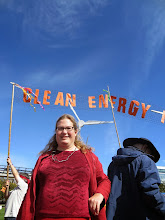The soft focus in this picture gives a dreamy feel, but it's 858 kilowatts worth of real - the country's second biggest solar garden in Rifle, Colorado (Sacramento's SMUD SolarShares still comes in at #1 with 1,200 kilowatts). This 5-acre field in Holy Cross Energy's territory was developed by Clean Energy Collective, engineered by Portuguese company Martifer, and installed by local Sunsense Solar. Former Colorado Governor Bill Ritter spoke at the dedication ceremony this morning.
About 20% of the panels available have been sold to Holy Cross customers. Solar Gardens Institute salutes the hard work that went into this project!
The Ownership Model
Most existing solar gardens are utility-owned, with panels leased to individual customers, who receive a credit on their electric bill. In the Rifle array, customers actually own particular physical panels, and the array is managed by a third party, for profit company.
I have a feeling we will be hearing a lot about this in the near future, so I'd like to give a sympathetic but hype-free view of the Clean Energy Collective model and it's plusses and minuses. As I understand it, the model consists of a set of contracts between customer, utility, array owner, and solar company that allows tax credit savings to be passed to the customer while not being treated as a security, such as a share of stock. These documents are proprietary (not open source), so my opportunity to evaluate them is limited to second hand information.
On the plus side, the Clean Energy Collective is one of the most advanced programs for community solar to date. It is implemented under federal law, which makes it nationally replicable (I do not believe, however, that it is the only replicable program). It does a great job of steering between the Scylla and Charybdis of tax and securities law. It is designed to last 50-100 years, managing a fund for array maintenance and panel upgrades.
One consequence of the program design is that funds may not be collected from individual customers before the array is built. Thus, a bridge loan is necessary until the panels can be sold. More importantly, customers of limited means cannot yet finance their purchases - and $500 or more for a single panel can be pretty daunting to many. A way for people to finance their panel purchases would allow arrays to be subscribed faster, and for everyone to go solar quickly.
Where Does SGI Fit In?
The Solar Gardens Institute has a mission that includes: To provide a way for everyone to own solar panels, making clean energy affordable and available for all humanity. A tall order, but something we take seriously!
In Colorado, cooperatives and nonprofits have broad exemption to securities law. As a joint venture, the Solar Panel Hosting Company and Tangerine Power have been working together to start a cooperative here in Colorado to facilitate ownership of solar by low and moderate income people (stay tuned for an announcement of this!)
People who already have solar and want to do more might invest in such a cooperative, sponsoring panel ownership for a low or moderate income individual. The panels purchased can go on the recipient's roof or in a solar garden. The sponsor could be anywhere in Colorado, and still support ownership in the Rifle array or any other solar garden. It's not charity - the sponsor gets paid back.
Moreover, with proper third party financing, a cooperative could stand alone as a subscriber organization. This ownership model for community solar has been used in New Jersey, Washington State, and Ontario, Canada.
Just over 20% of Colorado energy customers qualify for LEAP - Low-income Energy Assistance Program. A solar ownership program that could produce savings on monthly electric bills would be very attractive - but solar still costs a bit extra. A small grant, just enough to make the subscriber start to save each month, will greatly speed the adoption of solar. Given the budgetary state of affairs, this will probably have to be private money, via foundations or individual contributions. The Solar Gardens Institute would be the perfect vehicle for starting such a program.
At SGI, we look forward to working side-by-side with the Clean Energy Collective and all solar garden developers, financiers, installers, and subscribers, everywhere.



No comments:
Post a Comment